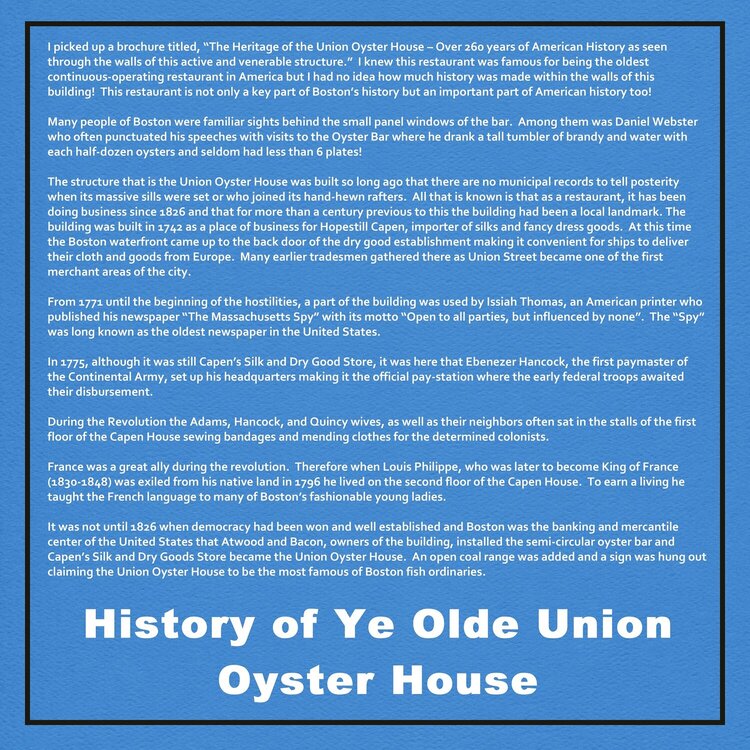

 Give a Cheer
Give a Cheer
The journaling is going to probably be very boring to everyone, but I wanted to remember the history of this old place.
JOURNALING: I picked up a brochure titled, “The Heritage of the Union Oyster House – Over 260 years of American History as seen through the walls of this active and venerable structure.” I knew this restaurant was famous for being the oldest continuous-operating restaurant in America but I had no idea how much history was made within the walls of this building! This restaurant is not only a key part of Boston's history but an important part of American history too!
Many people of Boston were familiar sights behind the small panel windows of the bar. Among them was Daniel Webster who often punctuated his speeches with visits to the Oyster Bar where he drank a tall tumbler of brandy and water with each half-dozen oysters and seldom had less than 6 plates!
The structure that is the Union Oyster House was built so long ago that there are no municipal records to tell posterity when its massive sills were set or who joined its hand-hewn rafters. All that is known is that as a restaurant, it has been doing business since 1826 and that for more than a century previous to this the building had been a local landmark. The building was built in 1742 as a place of business for Hopestill Capen, importer of silks and fancy dress goods. At this time the Boston waterfront came up to the back door of the dry good establishment making it convenient for ships to deliver their cloth and goods from Europe. Many earlier tradesmen gathered there as Union Street became one of the first merchant areas of the city.
From 1771 until the beginning of the hostilities, a part of the building was used by Issiah Thomas, an American printer who published his newspaper “The Massachusetts Spy” with its motto “Open to all parties, but influenced by none”. The “Spy” was long known as the oldest newspaper in the United States.
In 1775, although it was still Capen's Silk and Dry Good Store, it was here that Ebenezer Hancock, the first paymaster of the Continental Army, set up his headquarters making it the official pay-station where the early federal troops awaited their disbursement.
During the Revolution the Adams, Hancock, and Quincy wives, as well as their neighbors often sat in the stalls of the first floor of the Capen House sewing bandages and mending clothes for the determined colonists.
France was a great ally during the revolution. Therefore when Louis Philippe, who was later to become King of France (1830-1848) was exiled from his native land in 1796 he lived on the second floor of the Capen House. To earn a living he taught the French language to many of Boston's fashionable young ladies.
It was not until 1826 when democracy had been won and well established and Boston was the banking and mercantile center of the United States that Atwood and Bacon, owners of the building, installed the semi-circular oyster bar and Capen's Silk and Dry Goods Store became the Union Oyster House. An open coal range was added and a sign was hung out claiming the Union Oyster House to be the most famous of Boston fish ordinaries.
No products have been added to this project.
Thanks for spreading positivity!
October 30, 2016
October 30, 2016
October 27, 2016
October 27, 2016
October 26, 2016
October 26, 2016